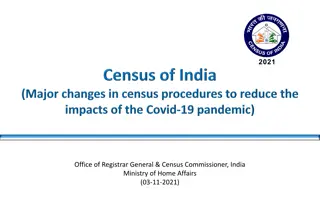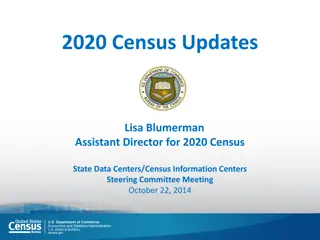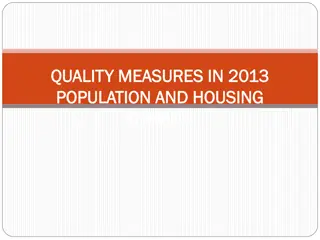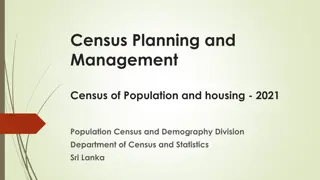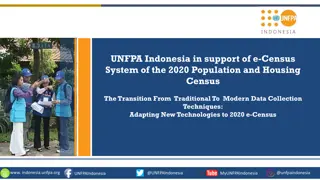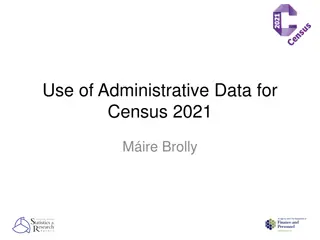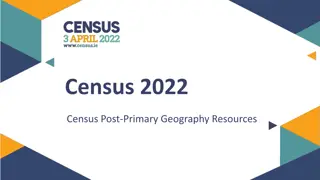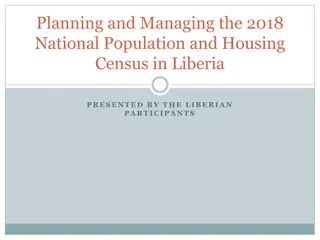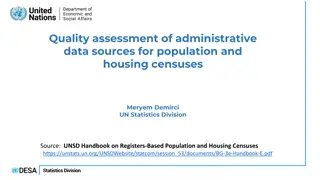Overview of the U.S. Federal Statistical System and Census Geography
The U.S. Federal Statistical System comprises 13 principal statistical agencies responsible for collecting and analyzing data across various sectors. The system includes agencies like the Bureau of Economic Analysis, Bureau of Labor Statistics, and U.S. Census Bureau. Geographic identifiers (GEOIDs and FIPS codes) play a crucial role in uniquely identifying different geographic areas for statistical data collection. The Standard Hierarchy of Census Geographic Entities outlines the structure of areas like Metropolitan Statistical Areas and Census Designated Places.
Download Presentation

Please find below an Image/Link to download the presentation.
The content on the website is provided AS IS for your information and personal use only. It may not be sold, licensed, or shared on other websites without obtaining consent from the author.If you encounter any issues during the download, it is possible that the publisher has removed the file from their server.
You are allowed to download the files provided on this website for personal or commercial use, subject to the condition that they are used lawfully. All files are the property of their respective owners.
The content on the website is provided AS IS for your information and personal use only. It may not be sold, licensed, or shared on other websites without obtaining consent from the author.
E N D
Presentation Transcript
U.S. FEDERAL STATISTICAL SYSTEM Janet Harrah, senior director Center for Economic Analysis and Development Haile College of Business Northern Kentucky University
13 PRINCIPAL STATISTICAL AGENCIES Bureau of Economic Analysis (Commerce Department) ** National Center for Education Statistics (Education Department) Bureau of Justice Statistics (Justice Department) National Center for Health Statistics (Health and Human Services Department) Bureau of Labor Statistics (Labor Department) ** National Center for Science and Engineering Statistics (National Science Foundation) Bureau of Transportation Statistics (Transportation Department) Economic Research Service (Agriculture Department) Office of Research, Evaluation, and Statistics (Social Security Administration) National Agricultural Statistics Service (Agriculture Department) Statistics of Income (Treasury Department) U.S. Census Bureau (Commerce Department) ** U.S. Energy Information Administration (Energy Department) Collectively, the U.S. government has more than 250,000 published data sets
STANDARD HIERARCHY OF CENSUS GEOGRAPHIC ENTITIES Metropolitan and Micropolitan Statistical Areas are collectively referred to as Core-Based Statistical Areas. Places are what most people refer to as cities. Census designated places: unincorporated communities that are locally recognized and identified by name (102 KY) Source: U.S. Census Bureau, July 2010
GEOGRAPHIC IDENTIFIERS (GEOID) GEOIDs are numeric codes that uniquely identify all administrative, legal and statistical geographic areas for which data are tabulated. The American National Standards Institute IANSI) maintains the Federal Information Processing Series (FIPS Codes) and Geographic Names Information System (GNIS Codes). The Census Bureau has published FIPS codes in census products for more than 30 years
FIPS FIPS Codes are assigned alphabetically Kentucky 21 EVERY geography that has data collected will have a unique FIPS code Counties in Kentucky Boone County, KY 21015 Campbell 21037 Kenton 21117 Cities in Kentucky are not nested and thus do not necessarily start with 21 Covington, KY 17848 Covington, GA 20064
DATA PITFALL BEWARE Not all geographies are stable over time. The data published for the Decennial Census are not updated to reflect changes in geographic definitions. Therefore, if you download data from the 1990, 2000, and 2010 Census for the Cincinnati MSA the data will not be geographically consistent over time. IMPORTANT: Some data sets are revised to reflect geographic changes while others are not. This is not consistent across Federal Statistical Agencies
DEFINITION OF CINCINNATI MSA COUNTIES ADDED AND DELETED CINCINNATI MSA: 2013 CINCINNATI MSA: 2018 Dearborn County, Indiana Grant County, Kentucky Dearborn County, Indiana Kenton County, Kentucky Franklin County, Indiana Kenton County, Kentucky Ohio County, Indiana Pendleton County, Kentucky Ohio County, Indiana Pendleton County, Kentucky Union County, Indiana Brown County, Ohio Union County, Indiana Brown County, Ohio Boone County, Kentucky Butler County, Ohio Boone County, Kentucky Butler County, Ohio Bracken County, Kentucky Clermont County, Ohio Bracken County, Kentucky Clermont County, Ohio Campbell County, Kentucky Hamilton County, Ohio Campbell County, Kentucky Hamilton County, Ohio Gallatin County, Kentucky Warren County, Ohio Gallatin County, Kentucky Warren County, Ohio Grant County, Kentucky Source: Census Bureau Delineation Files
GEOGRAPHY CHANGES Each year some new entities come into existence and other entities are dissolved. This may be the result of new incorporations or statistical delineations, the redrawing or splitting of administrative areas, disincorporations, mergers and consolidations, and other types of changes. The Census Bureau publishes an inventory of entity changes each year. BEST PRACTICE: Confirm each data source for each time period in your analysis is using the same geographic definitions. The same name is not sufficient evidence.
WHICH KANSAS CITY METRO DO I WANT? Note the FIPS codes are not the same
NON-STANDARD CES AREAS When metropolitan areas cross state boundaries, the state with the largest share of employment is referred to as the controlling state for the MSA; that is, it collects the relevant area data from the other state(s) and sums it to produce the final estimate value for the MSA. However, there are a few MSAs and Metropolitan Divisions where the non-controlling state s part represents a very significant percentage of the state s total statewide employment. In these cases the non-controlling states were interested in having a separate estimate for its portion because of its importance to the state. If the intrastate portion has an employment size of at least 250,000 and represents at least 15% of total statewide employment, acceptable estimates can be made for intrastate parts, and the parts sum to derive the official interstate definition. MSA code Area name Counties in area Bates County, Caldwell County, Cass County, Clay County, Clinton County, Jackson County, Lafayette County, Platte County, Ray County Johnson County, Leavenworth County, Linn County, Miami County, Wyandotte County 92811 Kansas City, Mo. 92812 Kansas City, Kan. Kansas City-Overland Park-Kansas City, MO-KS 28140 Includes all 14 counties
BLS GEOGRAPHY PICK LIST WHY IS CINCINNATI NOT LISTED? CONTROLLING STATE When metropolitan areas cross state boundaries, the state with the largest share of employment is referred to as the controlling state for the MSA; For Cincinnati the controlling state is Ohio For Louisville the controlling state is Kentucky
STATE LMI Each state Labor Market Information bureau, partners with the BLS to collect data using a consistent methodology.
RACE, ETHNICITY, ANCESTRY Race is associated with biology White, Black or African American, American Indian and Alaska Native, Asian, Native Hawaiian and Other Pacific Islander, Some other race, and two or more races Ethnicity is associated with culture Hispanic, Non-Hispanic Persons who identify their origin as Spanish, Hispanic, or Latino may be of any race Ancestry Refers to a person s ethnic origin or descent, "roots," or heritage, or the place of birth of the person or the person s parents or ancestors before their arrival in the United States. Examples include German, Chinese, or Egyptian. NOTE: The Federal Statistical System does not categorize data by religious belief or affiliation.
WILL WHITES REMAIN THE MAJORITY OF THE U.S. POPULATION? Percent of U.S. Population: White % U.S. Population: Non-Hispanic White 80% 80% 68% 70% 70% 60% 60% 50% 50% 44% 40% 40% 30% 30% 20% 20% 10% 10% 0% 0% 2016 2020 2025 2030 2035 2040 2045 2050 2055 2060 2016 2020 2025 2030 2035 2040 2045 2050 2055 2060 Data source: U.S. Census Bureau projections 2017-2060 Data source: U.S. Census Bureau projections 2017-2060
NAICS CODES The North American Industry Classification System (NAICS) is the standard used by Federal statistical agencies in classifying business establishments for the purpose of collecting, analyzing, and publishing statistical data related to the U.S. business economy. A numeric, hierarchical classification system that groups all business establishments into industries based on production processes. Detail level from a 2-digit sector to a 6-digit national industry
NAICS STRUCTURE SECTOR 2-DIGIT XX SUBSECTOR 3-DIGIT XXX INDUSTRY GROUP 4-DIGIT XXXX NAICS INDUSTRY 5-DIGIT XXXXX U.S. INDUSTRY 6-DIGIT XXXXXX
EXAMPLE OF NAICS STRUCTURE SECTOR 72 Accommodation and Food services SUBSECTOR 721 Accommodation INDUSTRY GROUP 7211 Traveler Accommodation NAICS INDUSTRY 72111 Hotels (except casino hotels and motels) U.S. INDUSTRY 721110 Hotels (except casino hotels and motels)
SOC CODES Standard Occupational Classification (SOC) system is a federal statistical standard used by federal agencies to classify workers into occupational categories for the purpose of collecting, calculating, or disseminating data. All workers are classified into one of 867 detailed occupations according to their occupational definition.
CIP CODES The Classification of Instructional Programs (CIP) is code system of instructional programs with the purpose to facilitate the organization, collection, and reporting of fields of study and program completions.
WHAT IS THE DEMAND FOR NURSES? What industries hire nurses (NAICS) What type of nursing occupations exist (SOC) What type of education is needed for each occupation (CIP) Crosswalks and matrices allow user to link data across coding systems CIP to SOC/SOC to CIP: https://nces.ed.gov/ipeds/cipcode/post3.aspx?y=56
NUMEROUS OTHER CODING SYSTEMS NAPCS North American Product Classification System used for classifying imports and exports NCES School ID is a 12 digit code identifying each school and school district in the U.S.
DATA SELECTION CRITERIA Release and revision schedule Geographic coverage Industry coverage Seasonal data availability Geographic changes time series updated or not to reflect changes
DATA SELECTION: RELEASE SCHEDULE EMPLOYMENT DATA BLS Current Employment Statistics: MONTHLY August estimates released 3rd week in September Census County Business Patterns: ANNUALLY 2019 data released April 2021 BEA Employment by Industry: ANNUALLY 2019 released in Nov. 2020 NOTE: revised statistics for 2013-2018
CAUTION: GROWTH RATES Month-to-month comparisons using non-seasonally adjusted data is equivalent to comparing apples to oranges. If you are using non-seasonally adjusted data year-over-year, monthly comparisons should be used. Comparing April 2011 to April 2012 is appropriate. Comparing April 2012 to March 2012 is not an apple-to-apple comparison.
DATA SELECTION: GEOGRAPHIC COVERAGE EMPLOYMENT DATA BLS Current Employment Statistics: U.S., STATES, METROS Census County Business Patterns: U.S., STATES, METROS, COUNTIES, ZIP CODES BEA Employment by Industry: U.S., STATES, METROS, COUNTIES
DATA SELECTION: INDUSTRY COVERAGE EMPLOYMENT DATA BLS Current Employment Statistics: Excludes: proprietors, the unincorporated self-employed, farm workers, domestic workers, and military personnel Census County Business Patterns: Excludes: self-employed, railroad employees, farm workers, postal services, most government employees BEA Employment by Industry: Includes: farm workers, private households, private elementary and secondary schools, religious membership organizations, railroads, military and the self-employed
DATA SELECTION: REVISIONS Best practice: Significant emphasis should not be placed on single or a few select data points when they are described as either preliminary or at any time prior to revision. Monthly and quarterly data, in particular, should be used to discuss general trends (up or down, fast or slow) with the recognition that the magnitude of change (e.g., a specific number or percentage) is likely to be revised up or down over time. Depending on the data set these revisions can be substantial.
FIRM VS. ESTABLISHMENT (CBP VS. STATISTICS OF US BUSINESS) Unit of analysis Uses Strengths Weaknesses Measures economic activity at the precise geographic (down to the county level) and detailed industry level (up to the six- digit NAICS code). Establishment-level data are critical to the full range of local decisions on training and economic development. At this level, comparisons across other local levels are possible if firm or enterprise identifiers are available. Higher level data (firm or enterprise) lose the ability to profile accurately by industry because cross-industry businesses cannot be uniquely assigned to a single industry. May not be the unit that determines economic decisions (profit maximization, hiring, etc.). Establishment data may not demonstrate the parent company's behavior. Measuring economic activity at precise industry and geographic locations. Data are available at the national, state, and county levels. Establishment Less precise industry and geographic information, because a firm may have multiple locations and multiple industries. Measuring economic activity in multi- establishment firms. Measures firm behavior and how firms adjust to economic conditions. Firm
CENSUS BUREAU Populations Estimates Program (administrative data and modeling) American Community Survey (sample survey) Decennial Census (head count) Used mostly for redistricting (fewer demographic data) BUT For 2020 the ACS will only release limited 1-year experimental estimates, which will not be available on data.census.gov CAUTION: you cannot compare Decennial Census and ACS data
COUNT VS. PERCENT One is not preferable; the question determines which is best Of the 120 counties in KY, 64 lost population between 2010 and 2019 Up 20.6% or 9,730 people, Scott was the fastest growing county Up 8.9% or 26,304 people, Fayette County added the most people At its current 2.1% average annual growth rate, Scott County would not have a population equal to Fayette in 50 years assuming zero population growth for Fayette
BIRTHS, DEATHS, NATURAL INCREASE Birth Rate = number of live births in a year for every 1,000 people in the total population Death Rate = number of deaths in a year for every 1,000 people in the total population Natural Increase = the difference between the birth rate and the death rate per 1,000 people Without migration if a region s natural increase is NEGATIVE, the region is losing population over time (think Japan) Huntington-Ashland, WV-KY-OH has experienced a negative natural increase over the past decade (a net loss of 3,285 people) coupled with out migration
2020 CENSUS: RACE & ETHNICITY It is important to note that these data comparisons between the 2020 Census and 2010 Census race data should be made with caution, taking into account the improvements we have made to the Hispanic origin and race questions and the ways we code what people tell us. We are confident that differences in the overall racial distributions are largely due to improvements in the design of the two separate questions for race data collection and processing, as well as some demographic changes over the past 10 years. For the most part, the media has ignored this caution 2 questions (Hispanic Origin and Race) Changes in the questions and instructions Changes in the coding of answers
2020 CENSUS: RACE & ETHNICITY FAYETTE COUNTY, KY 2010 Census 2020 Census Numeric Change Percent Change Total Population 295,803 322,570 26,767 9.0% Hispanic 20,474 29,750 9,276 45.3% Not Hispanic 275,329 292,820 17,491 6.4% Not Hispanic 275,329 292,820 17,491 6.4% Population of one Race 269,166 278,498 9,332 3.5% White 216,072 215,343 (729) -0.3% Black or African American 42,336 47,501 5,165 12.2% American Indian and Alaska Native alone 599 480 (119) -19.9% Asian alone 9,506 13,374 3,868 40.7% Native Hawaiian and Other Pacific Islander alone 107 133 26 24.3% Some Other Race alone 546 1,667 1,121 205.3% Population of two or more races: 6,163 14,322 8,159 132.4%
CENSUS DIVERSITY MEASURES Best Practice: Do not use majority/minority measures Diversity Index Prevalence rankings and diffusion score Prevalence maps
DIVERSITY INDEX (DI) DI: the chance that two people chosen at random will be from different racial and ethnic groups Ranges in value from: 0 (everyone has same rae/ethnicity) to 1 (nearly everyone in the population has a different race/ethnicity) In the real world the DI never equals 1 Thought question: With more corporations having diversity and inclusion goals, how does a mostly White, Non-Hispanic community address diversity and inclusion in its workforce?
PREVALENCE RANKINGS AND DIFFUSION SCORE Prevalence Rankings is just a fancy way of saying you are showing data for the 1st, 2nd, and 3rd largest minority groups within a region. The Diffusion Score is simply a measure of the percentage of the population not in the 1st, 2nd, or 3rd prevalence groups. The higher the score, the less concentrated the population is in the 3 largest race/ethnic groups. Prevalence Mapping: refers to mapping data for comparison geographies showing the geographic distribution of the largest or second-largest racial or ethnic group
EXAMPLE: NEW DIVERSITY MEASURES Scott County, Kentucky PREVALENCE RANKINGS, SCOTT COUNTY, KY: 2020 CENSUS Population by Race and Ethnicity: 2020 Census Total: 57,155 Percent of Total Population White alone 47,704 White alone 83.5% Hispanic or Latino 3,103 Black or African American alone 2,907 Hispanic or Latino 5.4% Population of two or more races 2,594 Asian alone 587 Black or African American alone 5.1% Some Other Race alone 185 0 0.1 0.2 0.3 0.4 0.5 0.6 0.7 0.8 0.9 American Indian and Alaska Native alone Native Hawaiian and Other Pacific Islander alone 56 Diffusion score = 6% 19
GROUP QUARTERS Group Quarters Population by Type Kentucky Fayette Co. Total Group Quarter Population 124,909 13,510 Percent of Total Population 2.8% 4.2% Institutionalized population: 66,512 3,969 Correctional facilities for adults 38,346 2,434 Juvenile facilities 1,090 26 Students are counted in the location of the University Nursing facilities/Skilled-nursing facilities 25,822 1,465 Other institutional facilities 1,254 44 Noninstitutionalized population: 58,397 9,541 College/University student housing 40,025 8,444 Military quarters 5,020 - Other noninstitutional facilities 13,352 1,097
AMERICAN COMMUNITY SURVEY BASICS Surveys 3.5 million addresses per year Informs $675 billion in Federal spending each year (all means tested programs) Covers 40+ topics Social: Ancestry, citizenship, disability, educational attainment, etc. Demographic: Age, Hispanic Origin, race, relationship, sex Economic: Commuting, employment status, Food Stamps, income, poverty, etc. Housing: Tenure, occupancy, vehicles, year built, etc.
AMERICAN COMMUNITY SURVEY: WHICH ONE TO USE? One-year Estimates (2 types) Five-year Estimates Large geographies Small geographies One-year 65,000 people minimum One-year Supplemental Estimates 20,000 people minimum Most precise estimates Most current estimate
GENERAL GUIDANCE FOR ACS Compare similar period (1-year and 5-year estimates are not comparable) Guides for comparison of data over time (Caution) Changes is geographic boundaries Changes in the questionnaire or coding DO NOT EXPECT ACS ESTIMATES TO MATCH DECENNIAL CENSUS
ARE ACS CHANGES STATISTICALLY SIGNIFICANT Most users ignore this question and simply use the estimates Caution: If your analysis will impact spending it is worth the effort to check for statistical differences especially for small geographic areas. The margins of errors can be quite large. No need to do the math yourself Statistical testing tool downloaded Excel file prepared by Census Bureau
POPULATION Total population Age and Sex Ancestry Language Spoken at Home Native and Foreign Born Residential Mobility (have you moved) Veterans
INCOME & POVERTY INCOME POVERTY Census Bureau s money income does not equal the Bureau of Economic Analysis personal income Census Bureau uses a set of money income thresholds that vary by family size and composition to determine who is in poverty. If a family's total income is less than the family's threshold, then that family and every individual in it is considered in poverty. The official poverty thresholds do not vary geographically. Money income does NOT reflect the value of noncash benefits such as food stamps, health benefits, and subsidized housing.
EDUCATION ATTAINMENT ENROLLMENT Educational attainment refers to the highest degree a person has received or the highest level of education that an individual has completed. Data on school enrollment captures the population who report being enrolled as a student in a program which leads to a high school diploma or college degree. Schools are designated as either public or private institutions. Except where it is counted separately, home schooling is considered private school









